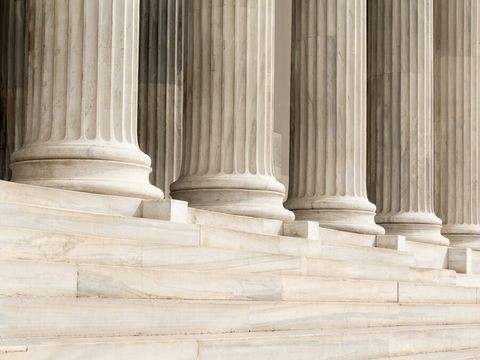Fast Lane to the Future: FCC Greenlights Smarter, Safer Cars
Client Alert | 3 min read | 12.10.24
The Federal Communications Commission (FCC) has recently issued a second report and order to modernize vehicle communication technology by transitioning to Cellular-Vehicle-to-Everything (C-V2X) systems within the 5.9 GHz spectrum band. This initiative is part of a broader effort to advance Intelligent Transportation Systems (ITS) in the U.S., enhancing road safety and traffic efficiency. While we previously reported on the frustrations with the long time it took to finalize rules concerning C-V2X technology, this almost-final version of the rule has stirred excitement in the industry as companies can start to accelerate development, now that they know the rules they must comply with.
Key Aspects of the Rule:
- Transition to C-V2X:The new rules replace the older Dedicated Short-Range Communications (DSRC) technology with C-V2X, which provides superior reliability and scalability. C-V2X enables real-time communication between vehicles, infrastructure, and road users like pedestrians and cyclists.
- Spectrum Allocation:The FCC allocated 30 MHz in the 5.9 GHz band for ITS, focusing on safety applications. This spectrum will be utilized through flexible channel arrangements to prioritize life-saving communications.
- Technical Standards:The rules specify operational parameters, such as power limits and interference protections, to ensure robust and efficient system performance.
- Geofencing and Flexibility:C-V2X devices can operate at higher power levels in areas away from federal radiolocation sites, improving their usability and range.
- Timeline and Legacy Systems:Existing DSRC systems will be phased out over two years, allowing the transition to C-V2X while minimizing disruptions to current users.
Standard Essential Patents:
The FCC’s new rule facilitating the adoption of C-V2X technology has direct implications on SEP’s. C-V2X relies on specific communication standards that are protected by patents deemed essential for implementation. This regulatory shift encourages widespread deployment of C-V2X, which could amplify licensing demands and disputes over SEPs among auto makers, technology providers, and patent holders.
As the market for connected vehicles expands, the role of SEPs in ensuring interoperability and access to technology becomes critical. Companies holding SEPs may negotiate licensing terms under fair, reasonable, and non-discriminatory (FRAND) obligations, but disagreements over royalty rates or licensing practices could lead to increased litigation or regulatory scrutiny. Furthermore, the integration of these technologies across various sectors might necessitate a clearer global framework to harmonize SEP licensing.
Takeaway:
This shift is expected to significantly improve road safety by enabling technologies like automated driving, non-line-of-sight awareness, and faster response to changing road conditions. Additionally, it aligns the U.S. with global trends in connected vehicle technology, fostering economic growth in the wireless and automotive sectors. The adoption of these new rules may also raise new considerations or challenges involving patents covering C-V2X, namely how various entities in the supply chain may license the technology. This very well may turn on the scope of individual patents but is something that all parties within the industry should consider as it is developing its products and as the new rules are rolled out.
The rules will take effect 60 days (about 2 months) after publication in the Federal Register, marking a major milestone in the modernization of U.S. transportation infrastructure. While this is a federal law, similar state and local laws will follow. However, the C-V2X and ITS worlds are also increasingly concerned about SEPs, and negotiations will become increasingly contentious.
Crowell & Moring LLP can help you navigate the laws concerning EV, C-V2X, ITS, and other issues concerning connected and autonomous vehicles. Please contact one of the undersigned for more information or questions.
Contacts
Insights
Client Alert | 5 min read | 12.12.25
Eleventh Circuit Hears Argument on False Claims Act Qui Tam Constitutionality
On the morning of December 12, 2025, the Eleventh Circuit heard argument in United States ex rel. Zafirov v. Florida Medical Associates, LLC, et al., No. 24-13581 (11th Cir. 2025). This case concerns the constitutionality of the False Claims Act (FCA) qui tam provisions and a groundbreaking September 2024 opinion in which the United States District Court for the Middle District of Florida held that the FCA’s qui tam provisions were unconstitutional under Article II. See United States ex rel. Zafirov v. Fla. Med. Assocs., LLC, 751 F. Supp. 3d 1293 (M.D. Fla. 2024). That decision, penned by District Judge Kathryn Kimball Mizelle, was the first success story for a legal theory that has been gaining steam ever since Justices Thomas, Barrett, and Kavanaugh indicated they would be willing to consider arguments about the constitutionality of the qui tam provisions in U.S. ex rel. Polansky v. Exec. Health Res., 599 U.S. 419 (2023). In her opinion, Judge Mizelle held (1) qui tam relators are officers of the U.S. who must be appointed under the Appointments Clause; and (2) historical practice treating qui tam and similar relators as less than “officers” for constitutional purposes was not enough to save the qui tam provisions from the fundamental Article II infirmity the court identified. That ruling was appealed and, after full briefing, including by the government and a bevy of amici, the litigants stepped up to the plate this morning for oral argument.
Client Alert | 8 min read | 12.11.25
Director Squires Revamps the Workings of the U.S. Patent Office
Client Alert | 8 min read | 12.10.25
Creativity You Can Use: CJEU Clarifies Copyright for Applied Art
Client Alert | 4 min read | 12.10.25
Federal Court Strikes Down Interior Order Suspending Wind Energy Development



